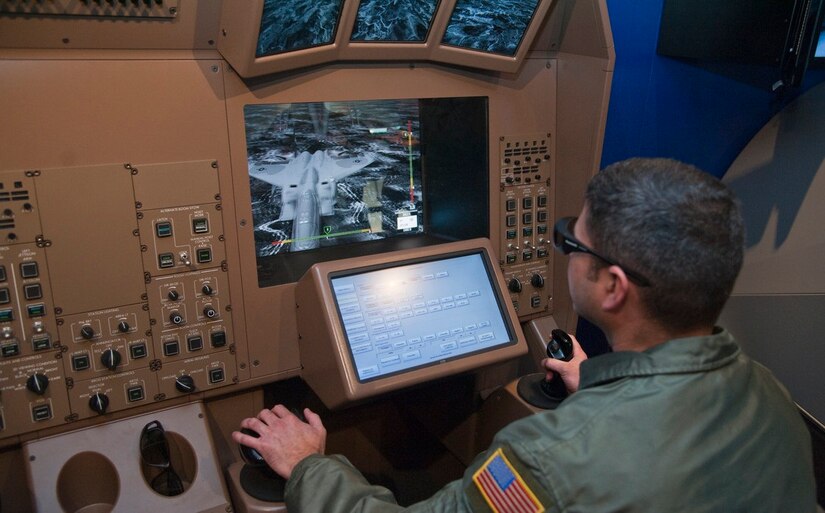
Current Test and Evaluation at Edwards Air Force Base is technically limited in easily discovering, reproducing, describing, evaluating, and training emerging 3D-related issues. However, there are multiple 3D-capable systems currently fielded or potentially coming to the USAF; e.g. KC-46 remote vision system (RVS), HC-130J Large Aircraft Infrared Countermeasures upgrade, F-35 3D-capable head-mounted display, etc.
In order to prepare and improve Edwards AFB testing capabilities for this emerging technology, a proposal is currently in work through AFWERX’s Small Business Innovation Research (SBIR) office to bring a 3D Video-review Ground Station (3D-VGS) to Edwards AFB.
The 3D-VGS is planned to allow 412th engineers (e.g. human factors, optics, etc.) and aircrew (e.g. KC-46 aerial refueling operators) to do the following:
- 3D-playback and review of unclassified 3D-video; e.g. video from the KC-46 RVS
- Playback as similar to the source environment as possible; i.e. viewing distances, etc.
- Integration of other display types; i.e. different 2D or active/passive 3D flat-screen commercial off-the-shelf displays, augmented reality and virtual-reality, etc.
- Integration of multiple 3D-video formats
- Event tagging in video; e.g. ”Here’s where this happened”
- Exportable video clips
- Easy video access: i.e. through a networked computer, portable hard-drive or CD/DVD, or local storage
- Future system upgrade to allow other playback options
“It would be an excellent instructional tool and also serve as a means to replicate issues noted in-flight for test purposes and maintenance troubleshooting,” said Staff Sergeant Andrew Miller, test boom operator, 418th Flight Test Squadron. “I see it being used fairly often for test and training missions, possibly every flight.”
When the 3D-VGS gets to Edwards, discussion is ongoing with 412th electro-optical systems engineers to include the 3D-VGS into the electro-optical/infrared lab complex planning. From initial discussion with the engineers, the 3D-VGS would fill their need to have a similar ground station in their human perception and performance lab. The 3D-VGS’ display modularity (i.e. plug-and-play different displays) would support 2D and 3D display and video review across multiple display types.
The idea for the 3D-VGS came from the lead human systems integration (HSI) RVS engineer on the KC-46. Throughout RVS testing, it was apparent test operators and engineers were extremely limited in how they could discover, reproduce, describe, evaluate, share, and train 3D-related issues, such as changes to depth perception, issues with visual acuity, and differences in binocular imagery.
As a result, it took over 3 years to understand and describe the few issues described in the current RVS Category 1 Deficiency Report (CAT 1 DR). Even after the HSI engineer was able to see a few of the 3D-related issues in-flight during testing, all of the 3D-related issues relied on both the AROs and engineer’s abilities to describe and understand very difficult things to describe and understand.
For example, how does a person experience depth perception? Are they sensitive to changes in depth perception? If a change is noticed, how detailed would someone be able to describe what they experienced? That was one of the key concerns trying to discern the impact of 3D-related issues like depth perception.
Attempting to reproduce the 3D-related issues was also difficult and not guaranteed. To reproduce the issue required scheduling another flight to investigate a specific flight condition that may not have been described sufficiently in the initial flight notes.
Eventually, many of the descriptions finally documented only came after the test crew (engineers and AROs) increased the priority of collecting all RVS in-flight details and after the understanding and vocabulary on RVS-related things increased; e.g., terms for human perception, optics and how cameras work, stereoscopic displays, etc.
If a 3D-VGS capability had been available during RVS testing, the test team would have been able to review all test video and pinpoint the majority of the issues. Additionally, other issues may have been found that are not described in the CAT 1 DR. Edwards AFB needs a 3D-VGS to help the engineering community more easily, effectively and efficiently discover, reproduce, describe, evaluate, and train on emerging 3D-related issues.
The 3D-VGS proposal is currently in SBIR Phase 1. The HSI RVS engineer is currently working with the chosen contractor to prepare the project for a Phase 2 decision in June/July. A prototype would most likely be developed over the next two years.
"Review" - Google News
June 25, 2020 at 04:14AM
https://ift.tt/3exzWap
Edwards AFB Prepares for 3D-Video Review Ground Station - Edwards Air Force Base
"Review" - Google News
https://ift.tt/2YqLwiz
https://ift.tt/3c9nRHD
Bagikan Berita Ini














0 Response to "Edwards AFB Prepares for 3D-Video Review Ground Station - Edwards Air Force Base"
Post a Comment